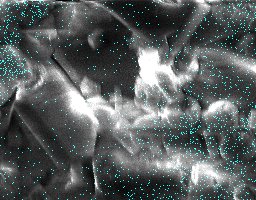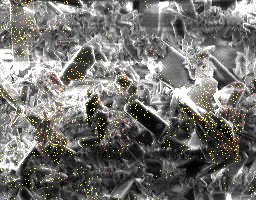Hey everyone! It’s Sky again.
We ran the IC this week and got some good anion and cation results for the most part! I’m still in the process of putting all the data together so I’ll talk about it more once I do. For most of the week, I have been helping Ana with her project and thus have gotten the chance to learn a lot of microbiology lab technique!! I’ve enjoyed it a lot. I’ve also made elemental maps of the SEM/EDS data we retrieved last week (some examples are pictured below).
Next week we have scheduled the SEM to get images of a few more membranes. The gold sputterer is broken, so some of our images have come out hazy (see top right image). The gold sputter holds stuff in place so the SEM can “see” the samples better. If it gets fixed in time, we will probably take images of all our samples a second time with gold sputtering. I’m still in the process of making my poster and haven’t gotten any feedback on my abstract yet. This is understandable, as Dr. Perreault has been in Canada all week and Ana has been incredibly busy trying to make deadlines. Maybe someone here can give me a little feedback? It’s not quite finished because there’s a piece of data I’m missing, but here we go:
Characterization of Inorganic Fouling and Recovery Limit in Membrane Distillation
Skyler Henry,1 Charles Dahill,1 and Francois Perreault1,2
1Nanosystems Engineering Research Center for Nanotechnology-Enabled Water Treatment, Arizona State University, Tempe, AZ
2School of Sustainable Engineering and the Built Environment, Arizona State University, Tempe, AZ
Membrane distillation (MD) is a promising desalination technique that uses a temperature gradient across a hydrophobic, microporous membrane that allows water molecules to evaporate through its pores and condense on the other side, leaving nonvolatile compounds behind. This research seeks to determine how the water recovery by an MD process is limited by the formation of inorganic species that blocks the pores of the membrane and increases the feed water’s resistance to flow. This information will give better insight into the scaling process so that future scaling prevention and reversal procedures can be developed. The general procedure includes identifying the recovery limit for a brackish oil and gas produced water by monitoring permeate flux during recovery, characterizing the membrane fouling using SEM/EDS and OCT microscopy and ion chromatography, and also modelling the change in bulk solution chemistry through the equilibrium modeling program Visual Minteq. It was found that permeate flux decay is dependent on both the initial ion concentration of the feed water and recovery time. In addition, equilibrium modeling has shown that the majority of foulants nucleated on the membrane are expected to be comprised of carbonate, sulfate, and calcium, and the EDS data appears to support this expectation [be more specific about this after mapping?]. [Insert sentence about IC findings when that data comes in]. It is suggested that future research be done on whether the threshold for recovery is dependent on membrane properties or temperature difference. These findings can also be used to compare inorganic fouling in traditional MD to that of solar MD.

